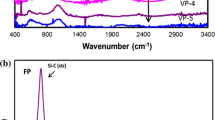Abstract
With the method of phenomenology, a supersaturation–condensation–fusion (SCF) mechanism is proposed to describe the growth of chemical vapor deposition silicon carbide under normal atmosphere. The structure has been characterized by scanning electron microscopy and transmission electron microscopy. Morphology characterization of deposited crystallites and silicon carbide aggregates have been explained in terms of SCF mechanism; Raman spectra analysis indicated that the major chemical bonds of deposit were Si–C and –C=C–. Auger spectra analysis revealed that there were Si, C, S, Cl, and O on the surface of the deposit.
Similar content being viewed by others
References
J. M. Jamet and P. J. Lmicq, in "High Temperature Ceramics Matrix Composites," edited by R. Naslain (Bordeaux:Woodhead; 1993) p. 735.
J. K. Strife and J. E. Shechan, Am. Ceram. Soc. Bull. 67 (1988) 367.
R. Naslain, in "Ceramic Matrix Composites," edited by R.Warren (London and New York: Champan & Hall, 1992) p. 199.
D. P. Stinton, T. M. Besmann and R. A. Lowden, Am. Ceram. Soc. Bull. 67 (1988) 350.
T. M. Besmann, R. A. Lowden and D. P. Stintion, in "High Temperature Ceramics Matrix Composites," edited by R. Naslain (Bordeaux: Woodhead, 1993) p. 215.
A. G. Suleyman, in "Proceedings of the 11th International Conference on Chemical Vapor Deposition," edited by K. E. Spear (American Electrochemical Society, Pennington, New Jersey, 1990) p. 1.
D. P. Stinton, W. J. Lackey, R. J. Lauf and T. M. Besmann, Ceram. Eng. Sci. Proc. 5 (1984) 668.
K. Minato and K. Fukuda, J. Mater. Sci. 23 (1988) 699.
D. Lespiaux, F. Langlasis and R. Naslain, ibid. 30 (1995) 1550.
W. J. Lackey, J. A. Hanigofsky, G. B. Freeman, R. D. Hardin and A. Prasad, J. Am. Ceram. Soc. 78 (1995) 1564.
D. P. Stinton, A. J. Caputo and R. A. Lowden, Am. Ceram. Soc. Bull. 65 (1986) 347.
T. M. Besmann, B. W. Sheldon, R. A. Lowden and D. P. Stinton, Science 235 (1991) 1104.
F. Sibieude and G. Benezech, J. Mater. Sci. 22 (1988) 1623.
C. W. Zhu, G. Y. Zhao, V. Revankar and V. Hlavacek, ibid. 28 (1993) 659.
H. W. Emmons, "Fundamentals of Gas Dynamics (Section F)" (Princeton, Princeton University Press, 1958) p. 3.
E. J. Givargiaov, "Current Topics in Materials Science" (New York: North-Holland, 1978) p. 91.
Rights and permissions
About this article
Cite this article
Xu, Y., Cheng, L., Zhang, L. et al. Morphology and growth mechanism of silicon carbide chemical vapor deposited at low temperatures and normal atmosphere. Journal of Materials Science 34, 551–555 (1999). https://doi.org/10.1023/A:1004546712932
Issue Date:
DOI: https://doi.org/10.1023/A:1004546712932



